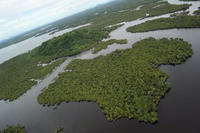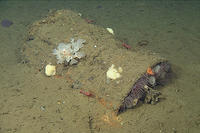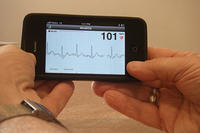-
Reducing radioactivity in fracking waste
In hydraulic fracturing — or fracking — millions of tons of water are injected at high pressure down wells to crack open shale deposits buried deep underground and extract natural gas trapped within the rock. Some of the water flows back up through the well, along with natural brines and the natural gas. This “flowback fluid” typically contains high levels of salts, naturally occurring radioactive materials such as radium, and metals such as barium and strontium. Much of the naturally occurring radioactivity in fracking wastewater might be removed by blending it with another wastewater from acid mine drainage, researchers find.
-
-
Interim nuclear agreement with Iran goes into effect 20 January
The United States and the EU announced Sunday that on 20 January Iran will start implementing November’s “comprehensive agreement.” One of the main clauses in the agreement calls for Iran to begin eliminating its stockpile of highly enriched uranium – that is, uranium enriched to 20 percent or higher — in eight days’ time from the start date. In addition to eliminating its stockpile of 20 percent enriched uranium before the end of January, Iran will also freeze other aspects of its nuclear program, accept more rigorous inspections of its nuclear facilities, and disable the cascade that produces 20 percent-enriched uranium. In exchange, Iran would receive some the relief from the sanctions, providing a $7 billion boost to the Iranian economy. The bulk of relief is in the shape of $4.2 billion in restricted Iranian assets which will be repatriated to Tehran in regular instalments throughout the six months until the deal concludes in July.
-
-
New system uses low-power Wi-Fi signal to track moving humans -- even behind walls
The comic-book hero Superman uses his X-ray vision to spot bad guys lurking behind walls and other objects. Now we could all have X-ray vision, thanks to a new system developed by researchers at MIT. The system, called “Wi-Vi,” is based on a concept similar to radar and sonar imaging. But in contrast to radar and sonar, it transmits a low-power Wi-Fi signal and uses its reflections to track moving humans. It can do so even if the humans are in closed rooms or hiding behind a wall.
-
-
Small, portable, fast TLC unit for explosives, drugs analysis
Field Forensics of St. Petersburg, Florida, unveiled its microTLC, a portable and easy to use solution for pre-screening and presumptive identification of drugs and explosive mixtures. Thin layer chromatography (TLC) is an established laboratory procedure which identifies compounds belonging to the same general chemical class. The microTLC makes it possible for both laboratory and field analysis to be performed by first responders and forensics scientists.
-
-
Arafat died of natural causes, not radiation poisoning: Russian investigators
A team of Russian physicians and scientists investigating the 11 November 2004 death of Palestinian leader Yasser Arafat has concluded that his death was not caused by radiation poisoning. The conclusions of the Russian team are a blow to the Palestinian leadership, which, since 2004, has accused Israel of being behind Arafat’s death. The Russian team’s findings follow the findings of two other scientific investigative teams: a Swiss medical team, funded by Arafat’s widow, concluded that the radiation poisoning of Arafat could not be ruled out. The French scientific team, appointed by a French judge, concluded that the levels of polonium-210 in Arafat’s personal effects, and the complete absence of the radioactive isotope in his body tissues, made it impossible for Arafat to have been poisoned by polonium. The Russian team, hired by the Palestinian authority, reached the same conclusion the French team did. “It was a natural death; there was no impact of radiation,” Vladimir Uiba, the head of the Russian Federal Medical and Biological Agency, said.
-
-
Dolphin-inspired innovative radar system to detect surveillance, explosive devices
Inspired by the way dolphins hunt by using bubble nets, scientistshave developed a new kind of radar that can detect hidden surveillance equipment and explosives.The twin inverted pulse radar (TWIPR) is able to distinguish true targets, such as certain types of electronic circuits that may be used in explosive or espionage devices, from clutter (other metallic items like pipes, drinks cans, nails for example) that may be mistaken for a genuine target by traditional radar and metal detectors.
-
-
Uranium found to be mobile in a natural wetland

Because they are known to mop up pollutants, artificial wetlands are considered to be an efficient strategy to contain waterborne uranium. Studying a natural wetland near a former uranium-mining site in the French region of Limousin, however, researchers have found that under certain circumstances, uranium can be partly remobilized into the surrounding water. The researchers show how it becomes mobile again by binding to tiny metallic and organic compounds with a little help from ambient bacteria.
-
-
Guards at U.K. nuclear weapons facility slept on the job, skipped routine patrols
Police officers of the U.K. Ministry of Defense police, assigned to guard Britain’s nuclear weapons, are under investigation after it has been reported that they had slept on the job and failed to complete routine patrols at a nuclear weapons facility. The Atomic Weapons Establishment (AWE) in Burghfield, Berkshire, is the location of the complex final assembly of nuclear weapons, and also where the U.K. nuclear warheads are maintained and decommissioned.
-
-
Survey of deep-sea chemical munitions dump off California finds no chemical weapons

Since the Second World War, U.S. nautical charts have shown seven “chemical munitions dumping areas” along the Pacific Coast between San Francisco and the Mexican border. Little or no information, however, is available about the amount, location, or nature of the materials that were dumped at most of these sites. Researchers from the Monterey Bay Aquarium Research Institute (MBARI) conducted a detailed survey of one supposed deep‐water dump site off Southern California, and found that it contained no chemical munitions. The researchers conclude that not all sites marked as chemical munitions dumps may actually have been used for this purpose.
-
-
U.S. “bomb library” marks 10-year anniversary
It has been ten years since the FBI established the Terrorist Explosive Device Analytical Center (TEDAC), and since that time the multi-agency operation — sometimes referred to as America’s bomb library — has become an important tool in the nation’s fight against terrorism. Since its creation in 2003, TEDAC has examined more than 100,000 IEDs from around the world and currently receives submissions at the rate of 800 per month. Two million items have been processed for latent prints — half of them this year alone.
-
-
India-Pakistan nuclear war would lead to world-wide famine: study
An India-Pakistan nuclear war may see the use of about 100 Hiroshima-size bombs – about half of India and Pakistan’s nuclear arsenals. A new study says that a nuclear exchange on such a scale would “probably cause the end (of) modern industrial civilization as we know it” by subjecting about two billion people to the risk of starvation, and causing massive economic and social disruptions far away from the theater of war. Among the consequences of a nuclear exchange: Chinese winter wheat production could decline by 50 percent during the first year and by more than 30 percent over ten years; there would be a 21 percent decline in Chinese middle-season rice production during the first four years and an average 10 percent decline in the following six years; corn and soybean production in the United States would decline by 10 percent on average for ten years.
-
-
Air transportation data helps identify, predict pandemics
Computational model demonstrates how disease spreads in a highly connected world. The computational work has led to a new mathematical theory for understanding the global spread of epidemics. The resulting insights could not only help identify an outbreak’s origin but could also significantly improve the ability to forecast the global pathways through which a disease might spread.
-
-
Lawmakers: Old plastic gun law has not kept pace with technology
The U.S. House of Representativesvoted last Tuesday to renew the 25-year old Undetectable Firearms Actwhich prohibits firearms that can evade metal detectors and X-ray machines. Law enforcement agencies say that developments in 3D printing make the law insufficient, and lawmakers who proposed amending the Act say that the only way to make such guns detectable is to require that at least one component of the firing mechanism in a plastic gun contain enough metal to be detectable in a magnetometer — and that that component be undetachable. The NRA opposes these requirements, saying that they would infringe on the Second Amendment rights of citizens.
-
-
Airport scanner vendor failed to disclose use of Chinese components
Recently TSA cancelled a $60 million contract with Rapiscan Systems, a manufacturer of anatomically revealing airport security scanners, after Rapiscan was found to be using unapproved Chinese components in its scanners – and failing to disclose this fact to TSA. Rapiscan, in bidding on the contract, submitted a list of U.S.-made components used in the scanners to the agency, as required by law. After the company received an approval of that list – and the $60 million contract – it ordered the same components from a Chinese company — the Shanghai Advanced Non-Destructive Testing – instructing the Chinese company to label the Chinese-made components with the same part numbers as the originally approved, U.S.-made components, apparently in an effort to make it more difficult for TSA inspectors to notice the illegal switch. Members of the House Homeland Security Committee, charging that the use of Chinese components made the machines susceptible to sabotage, disruption, or spying, want to know whether TSA was aware of Rapiscan’s shenanigans.
-
-
Airport screeners miss unusual – and possibly dangerous -- items

A smartphone app that turns gamers into airport baggage screeners is showing that finding weapons and other illegal items is not all that easy, even when you are looking for them. Researchers analyzed data from searches of twenty million virtual suitcases in the game Airport Scanner created by Kedlin Co. and found that users failed in most cases to identify objects that occurred only rarely. The reason: Commonly found objects may be crowding out identification of the unusual items.
-
More headlines
The long view
Keeping the Lights on with Nuclear Waste: Radiochemistry Transforms Nuclear Waste into Strategic Materials
How UNLV radiochemistry is pioneering the future of energy in the Southwest by salvaging strategic materials from nuclear dumps –and making it safe.
Model Predicts Long-Term Effects of Nuclear Waste on Underground Disposal Systems
The simulations matched results from an underground lab experiment in Switzerland, suggesting modeling could be used to validate the safety of nuclear disposal sites.
